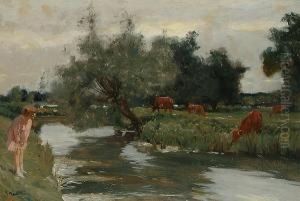Arhter Wardle Paintings
Arthur Wardle was a notable British artist born in 1864, whose career spanned the late Victorian era into the 20th century, concluding with his death in 1949. Although not as widely recognized as some of his contemporaries, Wardle's work remains highly appreciated among enthusiasts of animal paintings, to which he devoted the majority of his artistic endeavors. His ability to capture the essence and vitality of his subjects has earned him a respected place in British art history.
Wardle was largely self-taught, which makes his technical proficiency and detailed understanding of animal anatomy all the more remarkable. He displayed a remarkable talent for both domestic and wild animals, showcasing a range that spanned from household pets to the exotic beasts of the African plains. His works were characterized by their vibrant coloration and dynamic compositions, capturing not just the physical accuracy of the animals, but also hinting at their emotional lives and natural environments.
Throughout his career, Wardle's work was exhibited at various prestigious venues, including the Royal Academy and the Society of British Artists, earning him widespread acclaim. Despite his focus on animal subjects, he was versatile, dabbling in portraiture and landscapes, though these areas of his oeuvre are less well-known. His paintings today can be found in private collections and museums, admired for their contribution to the genre of animal art.
Wardle's legacy is that of a dedicated and passionate artist who brought the animal kingdom to life on canvas. His work not only reflects the Victorian and Edwardian fascination with nature and empire but also stands as a testament to his personal commitment to observing and immortalizing the animal form. Even after his death in 1949, Arthur Wardle continues to be celebrated for his contribution to art, particularly in the field of animal painting.
